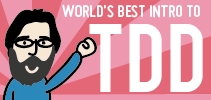What Makes an MVP?
Confusion abounds about what constitutes a Minimum, Viable Product, or “MVP”. This seems natural: as the term gained popularity, a larger group of people struggled to understand it, use it, and its meaning shifted. In many circles, “MVP” has become a kind of idiom: it has a meaning that no longer relates to its constituent words. The result? Confusion, anger, resentment, and a lot of wasted effort. I have no illusion that I can fix this problem with one short article, but I’d like to try to cut through the nonsense a little, if I can. First, let me see whether I understand the tensions at play.
Product?
I think people read too much into the word product, so I’ll set it aside quickly. Whatever we deliver, we call that “the product”. If we can sell it, or use it to sell something else later, then we call that “the product”. I don’t care what it is: a document, a toolkit, some features on a web site, a mobile app. If it encourages nice people to put cash in our pockets, then I consider that “the product”. Now let’s please stop worrying about that part.
Minimum? (or is it Minimal?!)
As I understand it, minimum has to do with cost. Not even cost—investment. We want to invest as little as we can in shipping a product, because we want to earn value earlier. I want Cash In My PocketSM. We need to minimize our investment for the same reason that we value Cash In My PocketSM: right now, cash is the bottleneck. We can’t afford to tie cash up in a longer-term investment, waiting for it to pay off. Goldratt called this flush, which he measured in dollar-days, meaning “money × time”. (For example, investing 100 000 ¤ for 60 days equals 6 000 000 ¤-days of flush.) We need to keep our flush low, but in terms of money invested and time invested. We want to deliver sooner, not faster. This force encourages us to try to deliver less, or cut corners, or abandon “the process”.
Viable?
As I understand it, viable has to do with value. More than that, perceived value. Either we want to encourage nice people to give us money or we want to prime nice people to want to give us money in the future. We need that money sooner because—surprise, surprise!—we want to earn value earlier. Once again, Cash In My PocketSM. Unfortunately, we don’t know how much value we have to provide before people will start giving us money. Figuring out that balance requires either clairvoyance or experimentation, and I don’t know any clairvoyants. Do you? The rampant uncertainty in the relationship between perceived value and the influx of cash encourages us to deliver more, or never deliver anything until we understand our market, or follow “the process” to the letter to avoid mistakes.
Confused Yet?
I can understand why so many people see so many different ways to understand “MVP”. I don’t feel terribly confident about how well I understand it myself! I know that it relates to early earned value, and so when in doubt, I come back to the literal meanings of these words. Pretending that I knew nothing else, what would I deliver in pursuit of early earned value?
I’d deliver anything I could that, for example, saves more work for my market than it adds. This sounds like one solid way to encourage them to give us money. I know that when someone saves me more effort than they cause me, I feel somewhat compelled to offer them money. Maybe you feel the same? At a minimum, when someone delivers a product to me that makes me have to do more than I did before I used the product, then I expect em to give me money as compensation. I literally want to send em an invoice. I don’t. Instead, I simply turn my back and tend not to give em a second chance—at least not until a bunch of my trusted colleagues tell me that e now offers a valuable product.
This feels actionable to me. What could you build that saves more work for your market than it adds? Once you figure that out, what could you build that requires a smaller investment that still saves more work for your market than it adds? Once you figure that out… you see where I’m going with this. Once you get stuck, I think you have an MVP. (Not “the” MVP. Just one among many possibilities.) Your MVP find not even be what you originally thought of as “a product”.
Can you arrive at an MVP other ways? Probably so, but this way might help you generate some better ideas, and especially it might help you avoid taking on more flush than you have to in order to start receiving Cash In Your PocketSM.
References
Goldratt, The Goal. He doesn’t mention flush until near the end, but if you haven’t read it yet, then you really do need to.
J. B. Rainsberger, “Sooner, Not Faster”. One of the mantras that has really stuck in my mind since Tim and I first discussed this in 2006. Nowadays people talk about the cost of delay. It sounds pretty similar to me.
Need Help?
If you’re not using techniques like these, then you’re missing out on most of the value of agile software development. Really! One CEO told me that learning techniques like these saved his company multiples of $100,000 in investment in software development. This is no joke. (If you don’t care about a few hundred thousand dollars either way, that’s fine, but it’s still a lot of money to me.)
Don’t waste your agile transition building the wrong product better. Learn more about Value-Driven Product Development training.
If you’re not ready for training, but you’d like me as your trusted adviser, get fractional consulting, coaching, and mentoring. It costs less than you’d think!

